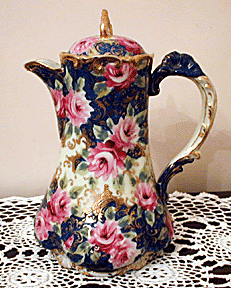 Antiques
command more attention today than ever before. So widespread is the
interest that people regard the fish-shaped amber bottle which held Dr.
Fisch's bitters in the early 19th century in the same way they do the
hanging lantern at Williamsburg. Nothing that was of personal or
household use during the last 300 years is too minor for consideration
in the 21st century. Yet hundreds of simple everyday articles that once
were indispensable now are left to gather dust or are unrecognized for
what they are.
Antiques
command more attention today than ever before. So widespread is the
interest that people regard the fish-shaped amber bottle which held Dr.
Fisch's bitters in the early 19th century in the same way they do the
hanging lantern at Williamsburg. Nothing that was of personal or
household use during the last 300 years is too minor for consideration
in the 21st century. Yet hundreds of simple everyday articles that once
were indispensable now are left to gather dust or are unrecognized for
what they are.
A cup
without a handle but with two saucers, a salt crock to hang on a kitchen
wall, a cream pitcher in the form of a cow with luster spots over its
white pottery body, an amber bottle shaped like a fish, a satiny rose
bowl whose glowing color belies its prim roundness--all these were
useful and probably treasured possessions in homes 85 to 150 years ago.
Today, people raise their eyebrows if someone serves tea a cup without a
handle. The salt crock would be considered downright unsanitary. Their
value lies in their being antiques. As such, they are as genuine as the
brass lantern with beveled glass sides that hangs in the hall of the
Governor's Palace, restored to its eighteenth-century splendor, in
Williamsburg, Virginia.
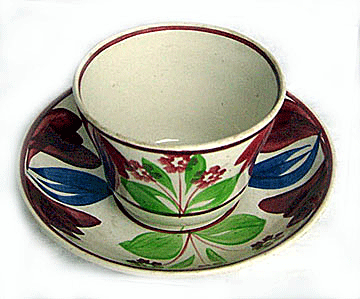 According to Webster’s Dictionary, an antique is "a piece of
furniture, tableware or the like, made at a much earlier period than the
present." It’s not, however, necessarily out-of-date or
old-fashioned. A chair that was built soundly from good hardwood around
1820 and is comfortable to sit on is never out-of-date. A 7-inch-high
octagonal teapot of blue Staffordshire is monstrous in comparison to
contemporary streamlined pots, but it makes as good a pot of tea as it
did more than a century ago.
According to Webster’s Dictionary, an antique is "a piece of
furniture, tableware or the like, made at a much earlier period than the
present." It’s not, however, necessarily out-of-date or
old-fashioned. A chair that was built soundly from good hardwood around
1820 and is comfortable to sit on is never out-of-date. A 7-inch-high
octagonal teapot of blue Staffordshire is monstrous in comparison to
contemporary streamlined pots, but it makes as good a pot of tea as it
did more than a century ago.
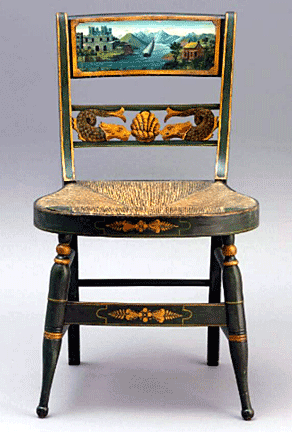 The
painted side chair with stencil decoration and rush seat, produced in
quantity and sold cheaply during the 1820's by Lambert Hitchcock, is
today worth quite a lot. He turned his Connecticut workroom into a
factory where he cut and turned the parts, assembled, and then
decorated, so that many more chairs were completed in a day than if a
workman had concentrated on one from start to finish. The Hitchcock
chair now is as undeniably an antique as a mahogany fiddle-back Empire
chair or a Chippendale ladder-back made many years earlier by
cabinetmakers. So also are a steeple clock of the 1860's, a pressed
glass lamp that burned whale oil during the 1840's or a brass student
lamp that burned kerosene in the 1880's, and the cut glass wedding
presents of the 1890's.
The
painted side chair with stencil decoration and rush seat, produced in
quantity and sold cheaply during the 1820's by Lambert Hitchcock, is
today worth quite a lot. He turned his Connecticut workroom into a
factory where he cut and turned the parts, assembled, and then
decorated, so that many more chairs were completed in a day than if a
workman had concentrated on one from start to finish. The Hitchcock
chair now is as undeniably an antique as a mahogany fiddle-back Empire
chair or a Chippendale ladder-back made many years earlier by
cabinetmakers. So also are a steeple clock of the 1860's, a pressed
glass lamp that burned whale oil during the 1840's or a brass student
lamp that burned kerosene in the 1880's, and the cut glass wedding
presents of the 1890's.
Not a
day goes by but that someone glances at some object and fails to
recognize it as an antique. For example, how many young women know a
sewing bird when they see one, and how to use it? They’re likely to be
baffled even when a small velvet pincushion is attached. The sewing
bird, usually of metal, is an ornamental clamp to be fastened to a
table. It holds fabric in its beak to facilitate hemming, and was a
great aid when all sewing was done at home. It's fun to use because the
beak is closed by a spring and can be opened by a tail lever.
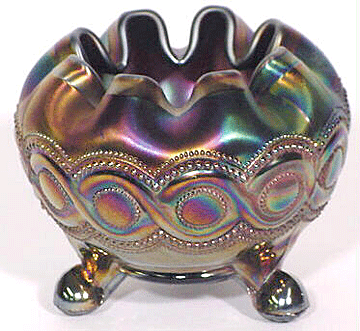 An
antique that has no appeal for one person or suggests no use is likely
to be a treasure to someone else, who will gladly pay for it. There are
two types of antique buyers: The ones who buy for the shear beauty or
use of a piece and the zealous collector who specializes in one
particular kind of object. Preferences range from such popular items as
pressed glass, a particular type of pottery, clocks, lamps, coins, coin
banks, bottles, souvenir spoons, and guns to oddments such as butter
pats, hatpin-holders, mustache cups, cut glass knife rests, and
toothpicks. Nothing is too small, too unimportant, or too queer but that
someone somewhere collects it.
An
antique that has no appeal for one person or suggests no use is likely
to be a treasure to someone else, who will gladly pay for it. There are
two types of antique buyers: The ones who buy for the shear beauty or
use of a piece and the zealous collector who specializes in one
particular kind of object. Preferences range from such popular items as
pressed glass, a particular type of pottery, clocks, lamps, coins, coin
banks, bottles, souvenir spoons, and guns to oddments such as butter
pats, hatpin-holders, mustache cups, cut glass knife rests, and
toothpicks. Nothing is too small, too unimportant, or too queer but that
someone somewhere collects it.
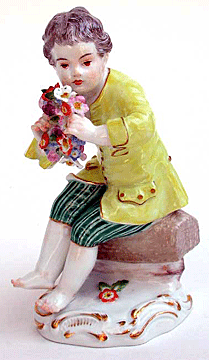 Many
collectors, including those who buy relatively inexpensive items such as
hatpin-holders, gradually assemble a group that becomes valuable in
terms of money. In contrast, there are people who literally buy antiques
as an investment which they expect to increase in value. Such things as
authentic Queen Anne and Philadelphia Chippendale furniture made here
during the 1700's, Meissen figurines, and Lowestoft china are currently
expensive examples of sound investments. Less costly now, but almost
certain to increase in value during the next 20 years, are furniture
made between 1850 and 1890, 19th-century brass, late 19th-century china,
and cut glass.
Many
collectors, including those who buy relatively inexpensive items such as
hatpin-holders, gradually assemble a group that becomes valuable in
terms of money. In contrast, there are people who literally buy antiques
as an investment which they expect to increase in value. Such things as
authentic Queen Anne and Philadelphia Chippendale furniture made here
during the 1700's, Meissen figurines, and Lowestoft china are currently
expensive examples of sound investments. Less costly now, but almost
certain to increase in value during the next 20 years, are furniture
made between 1850 and 1890, 19th-century brass, late 19th-century china,
and cut glass.
So what
makes one item–or even the same item–an antique or a collectible.
Generally speaking, antiques are rated by how old they are and by a
federal law (see my article What is an
Antique?). Collectibles, on the
other hand, can be defined as any object that people desire to collect.
This can be old hat pins or Hess toy trucks. Unfortunately, where the
line grays is in collecting “collectibles.” These are items made
specifically to be collected such as painted plates, dolls, toys (the
Hess trucks are a good example), etc. A whole industry has grown up
around collectible “limited editions,” as well as a misconception
that these items will be valuable. Their value–in fact, the value of
any item–is defined by how much someone is willing to pay for it. If a
lot of people want an item, then it’s value goes up. It’s the
age-old story of supply and demand.
To read
more of my articles, please
visit
my Web site.
<
Back to Antiques Articles
Next Article >
